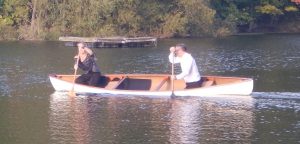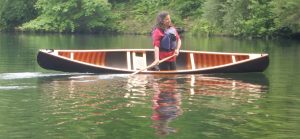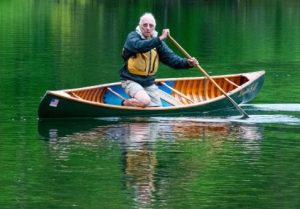Canoes and most other boats turn much like wheelbarrows. The stern rotates around the bow, unlike a car where the steering takes place up front. When the canoe is traveling forward and one tweaks the paddle in one way or another to initiate a turn, what one really does is give the stern a bit of a nudge. Barring any other forces, such as wind, current or other paddle manipulations, the stern will continue in the direction that it was nudged until the canoe runs out of momentum and comes to a stop. The greatest force resisting that turn is the water that must be pushed aside, by the stern of the boat, as it rotates. As I discussed in part 1 of this article, increasing rocker reduces the effort required to turn the canoe, but it does so evenly, reducing forces at both the bow and the stern. Pitching (or tipping the bow down) increases the forces on the bow but decreases the forces on the stern, where it counts most.

When one pitches the bow down the bow gets pressed deeper into the water, somewhat pinning it in place. At the same time the stern is raised, reducing the amount of water that it needs to push aside while turning.
If the pitch is mild, the effect is more subtle. The canoe may only appear to be a bit bow heavy. (below, left)

If the pitch is more significant, the stern may actually rise out of the water. Like rocker, this is something that you can control. (above, right)
When sitting, it is even more difficult to control pitch than it is to control rocker. The paddler can lean a bit forward but not much. When kneeling, one can come up partially or fully off the seat, effectively moving their full body weight forward.
Heeling and pitching can be combined. While heeling is often used alone, pitching is almost always combined with heeling to effect a tighter turn. Various body positions can be used to take full advantage of these techniques. Occasionally, you’ll see a paddler lunge forward, putting his or her knee on the rail which causes the canoe to heel and pitch radically. Most often, simply coming off the seat and onto ones knees is sufficient to get the job done. Entire classes have been devoted to this art.


I almost always paddle from a kneeling position, as it gives me the most control. With time and practice it’s quite comfortable, even for long periods of time. When traveling a twisty stream, I rarely make a turn without heeling a bit, often combined with some pitch. I’m constantly adjusting my canoe to the conditions at hand.
Heeling and pitching are both techniques that with practice will improve your boat control and increase your enjoyment of canoeing. They are two important skills that all serious paddlers should learn and use in their everyday paddling.
These two videos show an axle (a basic turn to the on side) using a modest heel, combined with some pitch to enhance the turn. The 1st video is at normal speed while the second is at ¼ speed.
1 https://www.youtube.com/watch?v=HidISfnNPAw
2 https://www.youtube.com/watch?v=AB_MTz5ud3c
This last video shows a group of paddlers traveling down a series of narrow, twisting streams using a variety of FreeStyle techniques, including heel and pitch.
https://www.youtube.com/watch?v=drM58OgHxO0
